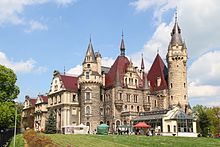Franz Hubert von Tiele-Winckler
Franz Hubert Graf von Tiele-Winckler (born March 10, 1857 in Miechowitz , Upper Silesia , † December 14, 1922 in Lucerne ) was a large German landowner, mining industrialist and Prussian district administrator from the Upper Silesian mining industrial family Tiele-Winckler .
Life
He was the son of Hubertus Gustav von Tiele († September 12, 1893) and Maria Valeska born. von Winckler (born August 26, 1829 - † March 18, 1880), the heir to a large industrial fortune in Upper Silesia. One sister was the deaconess Eva von Tiele-Winckler . He married Jelka von Lepel. With this he had the daughter Huberta, who later married Heinrich Harry Prince Reuss, Count of Plauen .
From 1886/87 to 1892 he was District Administrator of the Neustadt OS district in Neustadt in Upper Silesia . After his father's death in 1893, he inherited the property. This included the Palais Tiele-Winckler in the Tiergartenviertel in Berlin , built in 1872/1873 based on designs by Ebe & Benda (later used as the Spanish embassy). Since then, Franz Hubert von Tiele-Winckler has also been entail commissioner on Myslowitz and Kattowitz , Miechowitz and Rokittnitz. He had also inherited the family's mining industry. Even under his father, the mining industry was converted into the Kattowitzer AG for mining and ironworks in 1889 . Tiele-Winckler remained the main shareholder of this leading industrial company in Upper Silesia for many years until it was acquired by Friedrich Flick after his death . With a fortune of 74 million marks and an annual income of 3 to 4 million marks, he was eighth in the ranking of the richest inhabitants of Prussia in 1912. From 1901 he was a member of the Prussian manor house and was the state elder. He was a member of the Central Committee of the Reichsbank . He had the Moschen Castle built around 1900 .
He had been a member of the Corps Borussia Bonn since 1877 .
Individual evidence
- ^ Gothaisches genealogisches Taschenbuch der Briefadeligen houses, 1917, eleventh year, p.957
- ^ Kösener corps lists 1910, 19 , 510
literature
- Toni Pierenkemper: entrepreneurial aristocracy in Silesia . In: Elisabeth Fehrenbach (Hrsg.): Nobility and bourgeoisie in Germany 1770–1848 . Göttingen 1994; ISBN 3-486-56027-1 ; P. 154f.
- Klemens Skibicki: Industry in the Upper Silesian Principality of Pless in the 18th and 19th centuries . Stuttgart 2002; ISBN 978-3-515-08036-1
- Protocols of the Prussian State Ministry , Vol. 9: October 23, 1900 to July 13, 1909 , p. 425 (only two lines of life data in the personal register)
| personal data | |
|---|---|
| SURNAME | Tiele-Winckler, Franz Hubert von |
| ALTERNATIVE NAMES | Tiele-Winckler, Franz Hubert Graf von (full name) |
| BRIEF DESCRIPTION | German landowner, mining industrialist and Prussian district administrator |
| DATE OF BIRTH | March 10, 1857 |
| PLACE OF BIRTH | Miechowitz , Upper Silesia |
| DATE OF DEATH | December 14, 1922 |
| Place of death | Lucerne |

